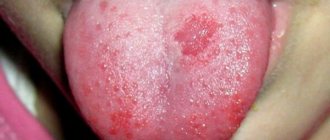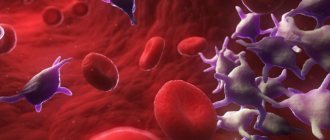About the spleen
While the embryo develops in utero, the spleen is responsible for the hematopoietic function, synthesizing platelets.
But as the fetus grows, its function changes - at the time of birth, platelet production moves to the bone marrow. However, if for some reason the bone marrow stops reducing blood cells, the organ will start working again. In addition, the spleen is responsible for the number of monocytes and lymphocytes in the blood. However, the main functions of the organ are completely different.
Purpose
The spleen has three functions in the human life system:
- immune (basic);
- purifying (filters blood);
- participation in protein metabolism (formation of immunoglobulins).
Location
The spleen is a bean-shaped organ located in the left hypochondrium. In an adult, its parameters are:
- length – up to 12 centimeters;
- width – up to eight centimeters;
- thickness - up to five centimeters.
Permissible deviations and norm
Normally, an increase in organ volume corresponds to changes in the child’s development.
- By twelve months, the baby’s spleen is: up to 65 millimeters in length and up to 25 in width;
- by two years: length – up to 72 millimeters, width up to 34;
- by six, can reach 71 millimeters, up to 41 in width;
- in adolescence it grows to a volume of 120 by 48;
- upon reaching adulthood it increases a little more: 121 by 51 millimeters.
If there is a suspicion that the size does not correspond to age, an ultrasound scan is prescribed - ultrasound, which will confirm or refute the assumption.
Age
The spleen begins to appear in the fetus at the earliest stage of pregnancy - 5-6 weeks after fertilization. This process ends by the fifth month of pregnancy. If at this most important stage the fetus is affected by negative factors (bad habits of the mother, genetic “failures”, toxins, an acute infection that the expectant mother fell ill with), then malformations of this organ are possible. Defects, as a rule, are of three types - the complete absence of an organ or the presence of two or more spleens in one body , as well as kinks and pinching.
Similar article - Essliver forte patient reviews
In a newborn, the lymphoid organ has a round shape and weighs only about 9 g. By the age of one year, the weight of this organ almost triples and is about 25-28 g. At 7 years old, the child’s spleen weighs more than 50 g, and at 16 years old - more than 160 g.
The presence of a healthy, normally functioning spleen is very important for childhood, because children are more susceptible to viral and bacterial infections. Without the participation of the spleen, resisting diseases will be much more difficult.
Causes of enlarged spleen in infants
Infectious diseases
One of the main prerequisites for disruption of the spleen, and this is usually an increase in its size, serious infectious lesions:
- measles;
- toxoplasmosis;
- tuberculosis;
- mononucleosis;
- rubella;
- diphtheria.
Pathologies of the circulatory system
The spleen will increase in infants and in case of disturbances in the circulatory system:
- with chronic hemolysis;
- lymphogranulomatosis;
- leukemia;
- osteopetrosis.
Organ growth cannot be ruled out in pathologies associated with inhibition of metabolic processes. For example, osteomyelitis or a manifestation of hereditary Gaucher disease.
Metabolic disorders
Having a hereditary metabolic disorder, the baby also runs the risk of experiencing abnormal enlargement of its organ. Several diagnoses are considered:
- glycogenosis (failures in glycogen metabolism);
- Wilson's disease (copper metabolism disorder due to genetic pathology of the nervous system and liver);
- essential hyperlipidemia (disorder of the fat metabolism mechanism);
- hemochromatosis (improper iron metabolism due to liver failure);
Focal lesions
In addition to diseases and painful conditions, structural disorders of tissues can be the cause of ill health. In infants - benign tumors, cysts, suppurations, in adults - local heart attacks and cancerous formations. Children are also characterized by abnormal enlargement of the organ due to helminthiasis (worms) caused by:
- The tapeworm Echinococcus is a dangerous parasite that causes serious damage to internal organs. Once in the spleen, they form cysts, causing atrophy of the parenchyma.
- blood flukes living in the venous circulatory system. Their eggs penetrate through the bloodstream into the tissue of the spleen, affecting it from the inside.
Schistosomiasis (schistosomiasis), along with echinococcosis, are common parasitic infestations.
Mycoses
The next reason for a change in the size of the spleen in a child is a fungal infection. Against this background, blastomycosis or histoplasmosis develops, with symptoms:
- pallor and yellowness of the skin;
- fever and fever up to 40°C;
- loose, foamy stools;
- enlarged liver and spleen;
- lung damage.
Therapeutic measures for splenomegaly
Treatment of the spleen includes various techniques and depends on the nature and stage of development of the disease. In critical situations (rupture, bleeding, complete loss of organ functions, necrosis, malignant tumors of the splenic tissue), surgical intervention is performed to partially or radically remove the spleen. However, this happens extremely rarely with children.
Drug therapy
The choice of medications for an enlarged spleen in children depends on the nature of the disease, its causes and stage of development.
In bacterial infections, antibiotics play a leading role. If we are talking about a pathology of a viral nature, antibiotics are powerless - antiviral drugs are needed.
Liver damage requires the use of hepatoprotectors.
Autoimmune diseases are treated with immunomodulators and vitamins.
If the examination shows that splenomegaly is caused by oncopathology of the splenic tissue, a course of specific antitumor drugs, both oral and injectable, as well as radiation or chemotherapy, may be prescribed. In case of low effectiveness of these techniques, partial or complete splenectomy is performed.
Diet

For splenomegaly in children, fresh fruits are recommended
Similar article - Tuberculosis of the knee joint
The diet of a sick child should include the following foods:
- meat: poultry, beef, fish, preferably sea. Frying as a cooking method should be replaced by boiling or baking;
- liver - beef, chicken;
- porridges and soups from cereals with water or with milk diluted with water in a ratio of 1 to 1. Buckwheat, which contains a lot of iron, is the healthiest;
- boiled and baked potatoes;
- chicken eggs;
- fresh vegetables and fruits: red beets, white cabbage, cranberries, citrus fruits (in the absence of allergies), sour apples (Antonovka and similar in taste).
Foods such as cheese, butter and whole milk, and ice cream should be limited. It is better to completely exclude sausages, canned food of all types, pasta and confectionery. You should also not eat chips, fast food, or carbonated drinks.
Physiotherapy
Motor activity with splenomegaly is forcedly limited, since the sick child feels constant weakness and quickly gets tired. But it is necessary to do breathing exercises: this helps to normalize the tone of the spleen and reduce its size.
The complex includes the following exercises:
- Lying on the floor or flat surface on your back, take a deep breath. Exhale in portions, saying “cha-cha-cha.” Repeat 15-20 times.
- As you inhale, pull your stomach in as much as possible, and as you exhale, push it out. Take 10-12 breaths.
- While standing, take a deep breath through your nose with your lips tightly closed. Exhale through your mouth, blowing air through pursed lips. Repeat 15 times.
These simple exercises should only be performed on an empty stomach. It is recommended to do them in the morning and evening, gradually increasing the number of repetitions to 40 times.
Folk remedies
The spleen is a small internal organ and not everyone knows where it is. But in physical education classes, many of us often complained of pain in the left side that appeared during or immediately after running. This is the spleen, and it reacts this way to a sharp increase in blood volume.
Despite the fact that the absence of a spleen generally does not affect general well-being and a person without a spleen can live peacefully, its removal is not a disaster for the body. But the spleen is still a very important organ for many reasons - it fights diseases of the blood and bone marrow, participates in the formation of humoral immunity (when the body’s defense system produces special antibodies that fight infections) and cellular immunity (cellular immunity is responsible for resisting bacterial and viral infections). It is also involved in the metabolism of iron, lipids, proteins and carbohydrates.
Symptoms of splenomegaly
Splenomegaly is more a symptom than a disease - a condition of an enlarged spleen that develops against the background of various pathologies.
Inflammatory forms
Splenomegaly itself is externally asymptomatic, but has signs of the disease that caused its development. For example, with the inflammatory nature of the enlargement of the spleen (bacterial or viral infections, worms, benign tumors), it manifests itself in the form of:
- diarrhea;
- acute pain in the area to the left of the abdomen;
- moderate nausea or vomiting;
- high temperature.
Non-inflammatory
Non-inflammatory form of splenomegaly, characteristic of:
- Hepatolienal damage (destruction of liver cells)
- Hemolytic anemia (breakdown of red blood cells)
- Thrombocytopenia (platelet transformation, increase in the number of megakaryocytes)
- Polycythemia (increased concentration of red blood cells, platelets and leukocytes)
- Mechanical factors (for example, impaired outflow of the splenic veins due to thrombosis).
In these cases, the symptoms are less pronounced, splenomegaly passes without temperature changes with mild aching pain.
Diagnostic methods
It is necessary to examine the child, even if there are no deviations from the norm. This is necessary in order to adequately assess his condition starting from the age of one month. Diagnostic procedures will be required:
- External examination, palpation, tapping;
- Biochemical study - assessment of liver functionality.
- Immunological – detection of infections or damage by parasites.
- Echography, scanning, computer diagnostics - determination of splenomegaly.
- Laparoscopy.
- Biopsy (rarely performed in young children due to the high likelihood of bleeding)
- MRI, computed tomography, ultrasound, x-ray - if there are difficulties with diagnosis.
Palpation of the spleen, unlike other organs, is a technically difficult element of diagnosis. The organ cannot be palpated in normal condition, and excess zeal can damage it. Therefore, only a specialist can palpate.
Identification of other diseases against which the development of splenomegaly can be expected is diagnosed by laboratory tests:
- general urinalysis;
- blood test: clinical;
- biochemical;
- sowing;
What to do?
When an enlarged organ is detected in a child, he is registered and his further condition is monitored.
Surgery, which was once widely used, is now rarely used. Only when the size of the enlarged spleen is too large (it has been proven that its removal makes the baby vulnerable to infections).
Treatment is carried out in three areas:
- Treatment of the disease causing splenomegaly.
- Elimination of painful manifestations (pain, fever, vomiting or diarrhea).
- Complete restoration of the organ’s performance indicators.
For example, bacterial or viral infections are treated with antibiotics or antiviral drugs, and tumors and blood diseases are treated with antitumor drugs. Vitamin therapy helps with anemia and vitamin deficiency. Radiation therapy can also be used, as can drainage if pus has accumulated. Folk remedies for cleansing the blood and bile ducts.
However, if conservative treatment fails, when the child is at risk of splenic rupture or internal bleeding begins, splenectomy is prescribed.
If an organ excision operation is performed, parents should be aware that the baby will be susceptible to infections for up to 3 years.
Treatment and preventive measures
Doctors correct the size of the spleen taking into account the underlying disease. In case of bacterial infection of the body, the course of treatment consists of antibacterial drugs. Blood diseases and tumors are eliminated with antitumor drugs. The problem of anemia and vitamin deficiency is solved with the help of vitamin therapy.
If conservative treatment is unsuccessful or the baby is at risk of splenic rupture, doctors insist on splenectomy. Indications for organ excision also include essential chronic thrombopenia, congenital spherocytosis and splenic neutropenia with hemorrhagic diathesis. A side effect of surgery can be an increase in the child’s sensitivity to infectious diseases for a period of 5 weeks to 3 years.
- Don't panic if your tiny baby has an enlarged spleen. In the first days of life, the size of the organ depends on the degree of blood supply.
- Avoid touching your baby's painful tummy. The spleen is a delicate organ that can be damaged by inept palpation.
- Children with an enlarged spleen are advised to eat portioned meals and regularly consume juices. The juices of beets, carrots, radishes, and pomegranates are especially useful.











